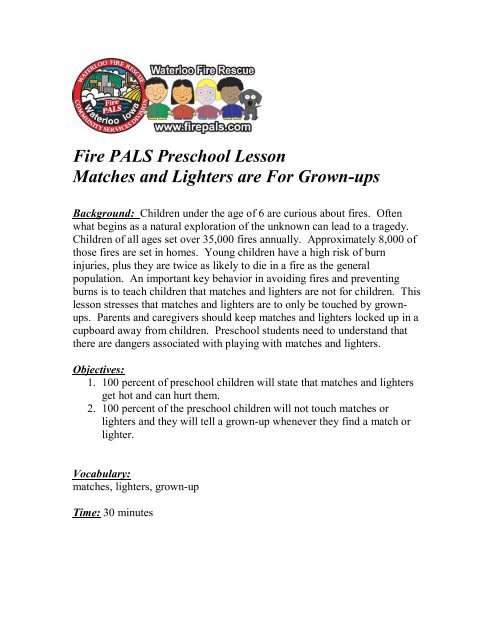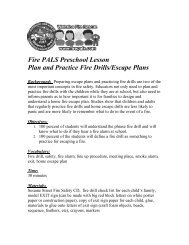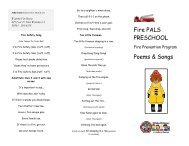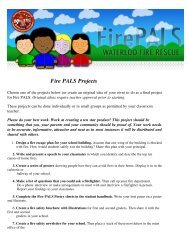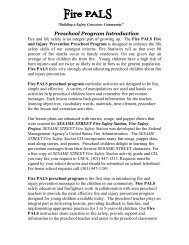Fire PALS Preschool Lesson Matches and Lighters are For Grownups
Fire PALS Preschool Lesson Matches and Lighters are For Grownups
Fire PALS Preschool Lesson Matches and Lighters are For Grownups
Create successful ePaper yourself
Turn your PDF publications into a flip-book with our unique Google optimized e-Paper software.
<strong>Fire</strong> <strong>PALS</strong> <strong>Preschool</strong> <strong>Lesson</strong><br />
<strong>Matches</strong> <strong>and</strong> <strong>Lighters</strong> <strong>are</strong> <strong>For</strong> Grownups<br />
Background: Children under the age of 6 <strong>are</strong> curious about fires. Often<br />
what begins as a natural exploration of the unknown can lead to a tragedy.<br />
Children of all ages set over 35,000 fires annually. Approximately 8,000 of<br />
those fires <strong>are</strong> set in homes. Young children have a high risk of burn<br />
injuries, plus they <strong>are</strong> twice as likely to die in a fire as the general<br />
population. An important key behavior in avoiding fires <strong>and</strong> preventing<br />
burns is to teach children that matches <strong>and</strong> lighters <strong>are</strong> not for children. This<br />
lesson stresses that matches <strong>and</strong> lighters <strong>are</strong> to only be touched by grownups.<br />
P<strong>are</strong>nts <strong>and</strong> c<strong>are</strong>givers should keep matches <strong>and</strong> lighters locked up in a<br />
cupboard away from children. <strong>Preschool</strong> students need to underst<strong>and</strong> that<br />
there <strong>are</strong> dangers associated with playing with matches <strong>and</strong> lighters.<br />
Objectives:<br />
1. 100 percent of preschool children will state that matches <strong>and</strong> lighters<br />
get hot <strong>and</strong> can hurt them.<br />
2. 100 percent of the preschool children will not touch matches or<br />
lighters <strong>and</strong> they will tell a grownup whenever they find a match or<br />
lighter.<br />
Vocabulary:<br />
matches, lighters, grownup<br />
Time: 30 minutes
Materials:<br />
tongue depressors with red tips to represent matches, copy of story, “Big<br />
Bird Finds a Lighter,” found on pages 1921 in Sesame Street <strong>Fire</strong> Safety<br />
Station” activity book, props for story (may include the following: Big Bird<br />
hat or Big Bird stuffed toy, straw basket with large h<strong>and</strong>le, toy butterfly net,<br />
box of birdseed, blue plastic sunglasses, lighter, pillows to make a large bird<br />
nest), an empty matchbook, song, “Hot Things Burn,” from Sesame Street<br />
<strong>Fire</strong> Safety Station CD.<br />
Procedure:<br />
This lesson contains two main parts; discussing <strong>and</strong> playing the game,<br />
“Find that match,” <strong>and</strong> reading <strong>and</strong> acting out the story, “ Big Bird Finds a<br />
Lighter.<br />
Part 1: Play “Find that Match” Game.<br />
1. During circle time, hold up a book of matches <strong>and</strong> a lighter. Ask,<br />
“Does anyone know what these <strong>are</strong>?”<br />
2. Discuss positive ways that adults use lighters <strong>and</strong> matches. (To light a<br />
fire in a fire place, to start a grill, to light birthday c<strong>and</strong>les,)<br />
3. Tell the students that matches <strong>and</strong> lighters <strong>are</strong> hot <strong>and</strong> can hurt or burn<br />
them.<br />
4. Tell the students that children <strong>are</strong> never to touch or pick up a lighter or<br />
matches. Teach them that if they see a match or a lighter the rule is:<br />
“Don’t touch, go tell a grownup.”<br />
5. Show the children your examples of “pretend” matches <strong>and</strong> empty<br />
matchbook. (Never use a matchbook that contains real matches.) Tell<br />
the students that you have hidden some in the room <strong>and</strong>, <strong>and</strong> that you<br />
want them to go looking for match books <strong>and</strong> matches with a friend.<br />
Explain to the children that if they find any, they must not touch them,<br />
but come <strong>and</strong> tell you what they’ve found <strong>and</strong> you will come <strong>and</strong> pick<br />
them up. Repeat the rule, “Don’t touch, go tell a grownup.” Have the<br />
children repeat the directions <strong>and</strong> the rule back to you.<br />
6. Pair the children up <strong>and</strong> have the children play this hide <strong>and</strong> seek<br />
game until they have found all of the hidden items. While you play,<br />
sing along with the song, Hot Things Burn,” from Sesame Street <strong>Fire</strong><br />
Safety Station CD. (Lyrics can be found on page 11 of Sesame Street<br />
<strong>Fire</strong> Safety Station activity book.) Throughout the week, without<br />
telling the children, place the pretend matches in the room. When a<br />
child discovers them, use the opportunity to discuss what children<br />
should do if they find the real item.
Part 2: Read <strong>and</strong> act out the story, “Big Bird Finds a Lighter.”<br />
1. Before class, assign children to play the parts of Big Bird <strong>and</strong><br />
Snuffy. Have a p<strong>are</strong>nt volunteer or associate teacher play the part<br />
of Luis at the Fix It Shop. Have pillows arranged in a circle to<br />
represent Big Bird’s nest, make a large paper nest out of cardboard<br />
or tag board, use a small craft store nest, or use a real bird nest that<br />
is no longer being used. The student playing Big Bird should put<br />
on the yellow hat, or carry the Big Bird stuff toy. The student<br />
playing Snuffy should put on the blue sunglasses. Give “Big Bird,”<br />
a large woven basket with a h<strong>and</strong>le. Prior to class put a nonworking<br />
lighter in Big Bird’s nest.<br />
2. Tell the children that you <strong>are</strong> going to read a story to them about<br />
Big Bird. Explain that you have chosen two students <strong>and</strong> a<br />
volunteer to help you act out the story. Say to the students, “In our<br />
story today, Big Bird goes out for a walk <strong>and</strong> when he returns to<br />
his nest he finds something that should not be there. Your purpose<br />
for listening to this story is to find out what it is <strong>and</strong> listen <strong>and</strong><br />
watch c<strong>are</strong>fully to what Big Bird does.”<br />
3. Tell the student that is playing the part of Big Bird, “While I read<br />
the story I want you to listen <strong>and</strong> do the things that Big Bird does.”<br />
You will have to cue the “Snuffy” character at the appropriate<br />
moment.<br />
4. Read “Big Bird Finds a Lighter.” This story can be found on pages<br />
1921 in Sesame Street <strong>Fire</strong> Safety Station activity book.<br />
5. Post Story Discussion Questions:<br />
· What <strong>are</strong> some things that Big Bird puts in his basket?<br />
· What did Big Bird find in his nest?<br />
· What did Big Bird do when he found the lighter?<br />
· Should Big Bird have picked up the lighter? Why or why<br />
not?<br />
· Should kids ever pick up lighters or matches? Why not?<br />
· What should you do if you ever find matches or lighters?<br />
Extension Activities<br />
1. Sing “Cookie’s Match rap,” which can be found on page 22 of<br />
Sesame Street <strong>Fire</strong> Safety Station activity book.<br />
2. Create a “<strong>Fire</strong> Station” learning center.<br />
Include items such as: firefighter costumes, hats, toy phone, bell to<br />
represent fire bell, pretend cb radio for dispatcher, large fire truck
cardboard cut outs that <strong>are</strong> easy for student firefighters to get in <strong>and</strong><br />
out of, fire safety coloring books <strong>and</strong> crayons.


